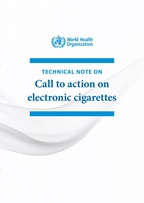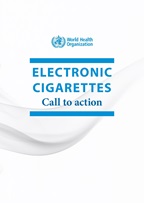Tobacco
Nicotine contained in tobacco is highly addictive and tobacco use is a major risk factor for cardiovascular and respiratory diseases, over 20 different types or subtypes of cancer, and many other debilitating health conditions. Every year, more than 8 million people die from tobacco use. Most tobacco-related deaths occur in low- and middle-income countries, which are often targets of intensive tobacco industry interference and marketing.
Tobacco can also be deadly for non-smokers. Second-hand smoke exposure has also been implicated in adverse health outcomes, causing 1.2 million deaths annually. Nearly half of all children breathe air polluted by tobacco smoke and 65 000 children die each year due to illnesses related to second-hand smoke. Smoking while pregnant can lead to several life-long health conditions for babies.
Heated tobacco products (HTPs) contain tobacco and expose users to toxic emissions, many of which cause cancer and are harmful to health. Electronic nicotine delivery systems (ENDS) and electronic non-nicotine delivery systems (ENNDS), commonly known as e-cigarettes, do not contain tobacco and may or may not contain nicotine, but are harmful to health and undoubtedly unsafe. However, it is too early to provide a clear answer on the long-term impact of HTPs and/or e-cigarette use.
An estimated 1.3 billion people worldwide use tobacco products, 80% of whom are in low- and middle-income countries. Tobacco use contributes to poverty by diverting household spending from basic needs, such as food and shelter, to tobacco. This spending behaviour is difficult to curb because tobacco is so addictive. It also causes premature death and disability of productive age adults in households thus leading to reduced household income and increased healthcare costs.
In addition to the detrimental impact of tobacco on health, the total economic cost of smoking (from health expenditures and productivity losses together) are estimated to be around US$ 1.4 trillion per year, equivalent in magnitude to 1.8% of the world's annual gross domestic product (GDP). Almost 40% of this cost occurred in developing countries, highlighting the substantial burden these countries suffer.
Tobacco taxes are applied in part to combat this effect and are seen as the most cost-effective way of curbing tobacco use, particularly among youth and low-income populations. A tax increase that increases tobacco prices by 10% decreases tobacco consumption by about 4% in high-income countries and about 5% in low- and middle-income countries.
The scale of this human and economic tragedy is shocking, but it’s also preventable. Big Tobacco — along with all manufacturers of tobacco products — is fighting to ensure the dangers of their products are concealed, but we are fighting back: In 2003, WHO Member States unanimously adopted the WHO Framework Convention on Tobacco Control (WHO FCTC), the only public health treaty under the auspices of WHO. In force since 2005, it has currently 181 Parties.
To help countries implement the WHO FCTC, WHO introduced MPOWER, a package of technical measures and resources, each of which corresponds to at least one provision of the WHO FCTC. MPOWER builds the capacity of countries to implement 6 measures to reduce the demand for tobacco products: monitor tobacco use and prevention policies, protect people from tobacco use, offer help to quit tobacco use, warn about the dangers of tobacco, enforce bans on tobacco advertising, promotion and sponsorship and raise taxes on tobacco.










.tmb-549v.png?sfvrsn=9aaa9ba7_2)







